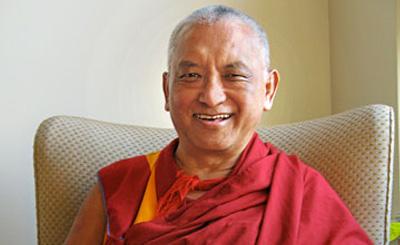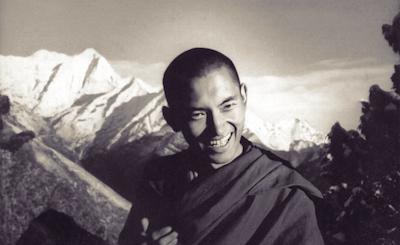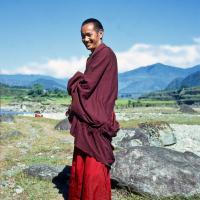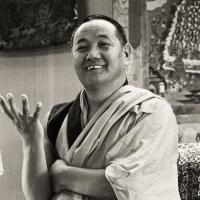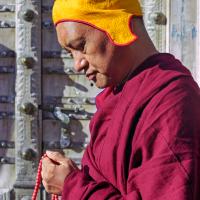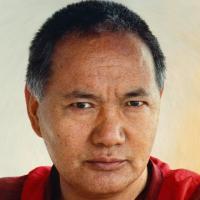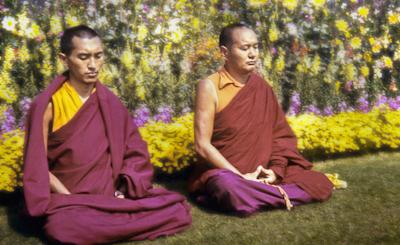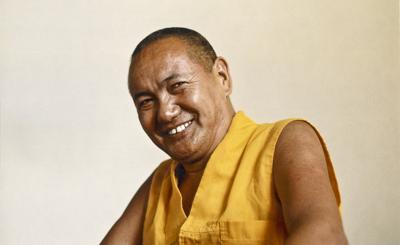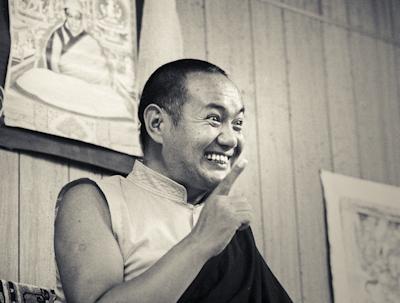Yesterday you received the Maitreya empowerment.19 Today I’m going to explain how to approach enlightenment by practicing the yoga method of Maitreya. The yoga method of Maitreya has two divisions: the preliminaries and the actual—or main body of the—meditation.
The preliminary practices
The preliminary meditations for the yoga method of Maitreya are taking refuge and generating bodhicitta, cultivating the four immeasurables and generating special bodhicitta but it’s not my job to describe them here.20 However, why are they here in this text? Why are they a part of this practice?
The preliminaries are a kind of warning signal, like traffic lights, telling you to be careful. They show the beauty of Tibetan Buddhism; they’re like an advertisement for Tibetan Buddhism. People nowadays are confused, both spiritually and in a worldly way, so what we need is a comfortable, step-like path to enlightenment, a process by which we can develop gradually, to ensure that our spiritual growth is natural and organic and that Dharma becomes us and we become Dharma.
Then the question may arise, “When practicing this sadhana, do we have to do the preliminaries every day?” They’re here in the text; do you always have to do them? I’m going to say no, you don’t. Then you’re going to ask, “Well, why are they there?” to which the answer is that since we have to develop gradually, they’re there to show us how to do that.
Refuge and bodhicitta
If you already have complete confidence in Buddha, Dharma and Sangha—the supreme enlightened being and his wisdom teachings and feel that meditation practitioners are your best friends in the world— that’s taking refuge. You don’t have to recite the refuge formula, “I take refuge in Buddha, I take refuge in Dharma, I take refuge in Sangha,” over and over. That way of taking refuge can be simply cultural and should be abandoned. Taking refuge is not verbal; there has to be something in your experience that leads you to feel that following the path shown by the Buddha is the way to gain complete liberation from suffering and you feel very comfortable with that. That’s the essence of taking refuge.
The cultural way of taking refuge—going to the temple in the morning and mindlessly intoning the refuge formula—might be good for some people and better than the Western way of taking refuge each morning in coffee and the bathroom, but still, refuge should come intuitively; then you don’t need words. The same goes for generating the enlightened attitude of bodhicitta—refuge and bodhicitta should both come intuitively, the way you want your morning coffee. When you’re habituated to coffee you don’t need to make an effort; your desire for coffee arises spontaneously. Similarly, when your mind is trained in refuge and bodhicitta, at a certain point you no longer need words.21
The four immeasurables
The same goes for the four immeasurables. If you have eliminated strong feelings of attachment for your dear friends and hatred for your despised enemies and have equal feelings for all, you don’t need to repeat the words. Verbal repetition is for those in whom the attitudes contained in the four immeasurables have not become intuitive. We need words to bring comprehension but once we have developed understanding wisdom and the four thoughts arise intuitively, we don’t need to meditate on them and we certainly don’t need the words.
Special bodhicitta
Special bodhicitta is the enthusiastic desire to quickly, even more quickly, develop ourselves as much as possible, not just to overcome our own confusion but to benefit others in the highest way. For tantric practitioners, therefore, the main aim is not to get enlightened but to enlighten others.
The reason I emphasize this point is that sometimes people get the wrong impression that Tibetan Buddhism thinks that getting enlightened is the most important thing, like grasping at a piece of fruit. It’s not at all like that.
Actually, you can understand the meaning from the words of the prayer. It says “for the sake of all mother sentient beings” not “for my sake.” People tell me, “Lama, before I met the Dharma I used to strongly desire worldly pleasures but now I strongly desire enlightenment. This is what Buddhism seems to say.” I agree; it’s an understandable misconception to think that the goal of Mahayana Buddhism is to attain enlightenment for yourself rather than for all sentient beings.
But bodhicitta is profound, a universal attitude completely free of craving and grasping. The enlightened attitude of bodhicitta encompasses all living beings throughout all of space while functioning in the space of your own heart.
Then the question might arise: “I have complete confidence in Buddha, Dharma and Sangha, am fully convinced that this is my path, have had some success in meditation and in eliminating at least my gross mental problems, and feel love, compassion, bodhicitta and a feeling of equanimity for all living beings—isn’t this enough?”
Isn’t it enough to feel love for all sentient beings and have the universal thought that they all should reach enlightenment as quickly as possible? What more do we need? Isn’t the practice of the preliminaries, which brings these results, enough? Why do we then need to progress to the main body of the Maitreya yoga method?
These are good questions and in a way it’s true—through practicing the preliminaries we can eliminate extreme desire and hatred and gain a clear and peaceful mind, but that’s not enough. Everyday emotions like hatred, jealousy, anxiety and so forth are merely symptoms arising from our ego, the root of all suffering, and until that is eradicated our spiritual growth will be stunted.
My scientific research into the Western world has opened my eyes; I see that Western religions also contain the preliminaries and value this kind of meditation. If you check the Bible wisely you’ll find them there.
The difference in Buddhism, however, is that we also teach shunyata, which is something the West badly needs and why I feel that the Buddha’s teachings are so useful for the Western mind. Only meditation on shunyata can eradicate the ego and that’s why the actual meditation, the main body of the yoga method of Maitreya, begins with meditation on emptiness. Furthermore, the tantric process of becoming one with a deity such as Maitreya is also non-existent in Western religions and that’s the principal meditation that we then go on to do.
Therefore I feel it’s extremely worthwhile that Buddhadharma has come to the West; the need for these practices is great.
NOTES
19 For an example of an initiation given by Lama Yeshe see Becoming Vajrasattva, chapter 11, “An Initiation into Heruka Vajrasattva.” [Return to text]
20 See Appendix 2 for the Preliminary Practices section of the Maitreya sadhana. [Return to text]
21 See Becoming Vajrasattva for more detailed teachings on refuge and bodhicitta in the tantric context. [Return to text]







